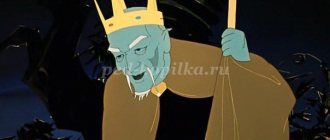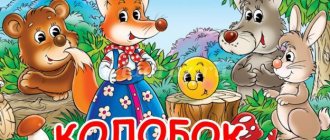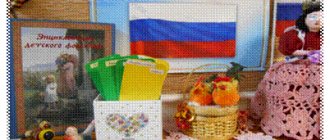GCD move.
Children answer: Kolobok .
Educator: Do you know what fairy tale ?
Educator: I suggest you sit back and listen to a fairy tale about him .
( The fairy tale “ Kolobok ” is read; while reading the teacher imitates the voices of the characters and shows illustrations to the fairy tale .)
After reading the fairy tale, the teacher asks the children to answer the questions:
— Did you like the fairy tale ? (answer: Yes.)
- Who is the main character of the fairy tale (answer: Kolobok .)
— Who met the bun ? (answer: Hare, wolf, bear, fox.)
- How does a bear growl? (answer: y-y-y.)
- What was the bun ? (children sing a song together with the teacher.)
Educator: Guys, our bun was able to roll away from the fox (shows the bun )
and he wants to play with you, what do you want?
Game “ Kolobok hot and cold ”.
Children stand in a circle, the teacher gives one of them a ball.
The teacher tells the children: The ball is a bun and you will pass it to each other in turns. If I say “ Kolobok is hot ,” you pass it quickly so as not to burn your hands, and if “ Kolobok is cold ,” then slowly. Let's play (answer: yes)
.
After playing, the teacher removes the ball, and the children sit on chairs.
The teacher asks questions:
- Guys, what fairy tale did we read (answer: Kolobok .)
— How the wolf and the bear growled (answer: r-r-r, y-y-y)
-What game did we play? (answer: Kolobok roll along the path )
The guys say goodbye to the kolobok .
Abstract of the GCD “Reading the Russian folk tale “The Cat, the Rooster and the Fox” by A. N. Afanasyev” in the second junior group. Synopsis of the GCD in the II junior group Topic: Reading the Russian folk tale “The Cat, the Rooster and the Fox” A. N. Afanasyev Integration of OO : social and communicative.
Notes on speech development in the first junior group. Reading the fairy tale “Hen Ryaba” Summary of direct educational activities for young children on speech development Reading the Russian folk tale “Hen.
Summary of a lesson on speech development in the second junior group. Reading the fairy tale by K. Chukovsky “Confusion” Topic: Reading the fairy tale by K. Chukovsky “CONFUSION” Purpose: * To promote awareness of the content of the poem. * Form a rule: matches for children.
Lesson notes for the first junior group according to the Federal State Educational Standard. Repetition of the fairy tale “Kolobok” Lesson notes for the 1st junior group according to the Federal State Educational Standard Educational area: “Speech development” Type of activity: “Communicative” Section: “Communication.
Productive reading and listening to the Russian folk tale "Zayushkina's Hut" in the second junior group. Plan - synopsis of an integrated lesson on the topic: "Productive reading - listening to the Russian folk tale "Zayushkina's Hut" in the second. Lesson on speech development in the younger group. Reading the fairy tale “Kolobok” BY ANYA ON SPEECH DEVELOPMENT IN THE SECOND YOUNGER GROUP TOPIC. READING THE RUSSIAN FOLK TALE “KOLOBOK” Educational areas: “Communication”,.
Lesson on speech development in the younger group. Modeling the fairy tale “Kolobok” A lesson on speech development, modeling the fairy tale “Kolobok” using geometric shapes for children of primary preschool age.
Lesson on speech development in the second junior group. Reading the Russian folk tale “Zayushkina’s Hut” to children. Lesson on speech development in the second junior group. Topic: Reading a Russian folk tale to children: “Zayushkina’s hut.” Goal: To introduce children.
Source
Notes on speech development for junior group 2 on the topic “Reading the fairy tale “Kolobok”
Olga Goryachkina
Notes on speech development for junior group 2 on the topic “Reading the fairy tale “Kolobok”
1.Goal: To introduce children to the Russian folk tale “ Kolobok ”
, introduction to oral folk art, continue to teach children
carefully look at illustrations in books.
-development of coherent speech and enrichment of children’s vocabulary;
-development of attention and memory of children;
-education for Russian folk tales ;
-development of the ability to describe what is seen.
3.Type of lesson: combined.
4.Form of the lesson: reading-discussion .
5.Duration: 15 minutes.
6. Participants: 2 junior group (10 people)
— 2
subgroups.
7.Age of students: 3-4 years.
8.Equipment and materials: books with the fairy tale “ Kolobok ”
various artists, toy
bun , mnemonic table based on a fairy tale .
-verbal: reading fairy tales , children's stories , conversation;
-visual: looking at illustrations.
10. Lesson structure.
1. Introductory part Checking children’s readiness for class (appearance, attention span)
1 minute
2. Main part Organizing children's attention (surprise moment)
,
reading a fairy tale
and looking at illustrations in books. 10 minutes
3.End of the lesson Summing up: description of the fairy tale by children using a mnemonic table and assessment of children’s participation. 4 minutes
The chairs in the group are placed in a semicircle, the children sit on the chairs.
There is a knock on the door. The teacher opens and asks the children a riddle:
-It was baked from flour,
It was mixed with sour cream,
He was chilling at the window,
He rolled along the path.
He was cheerful, he was brave
And on the way he sang a song. Who is this?
-Right. This is a bun . (Teacher shows a toy kolobok )
.
-Who knows the fairy tale about our kolobok ?
-Let's read a fairy tale about our guest , I think he will be pleased with our interest.
The teacher reads a fairy tale , trying to convey emotions.
-Are you tired? Let's relax a little and play with our hands. Repeat after me.
-Knead the dough quickly (open and close your palms,
- Divided into pieces (simulate pinching off,
-Roll out all the pieces (three palms together)
-And we made little buns (we show 2 fists)
-Now let's go to the table. What lies on it? - Books.
-That's right, books about our hero. different artists depicted . (Children look at books with images of koloboks .)
-Which bun did you like best and why?
Children answer and describe.
3. End of class.
-We looked at the illustrations, told why we liked the koloboks , and now, using our table, let’s repeat the fairy tale .
Next, the teacher gently evaluates each child’s participation.
Children tell a fairy tale .
V.V. Gerbova “ Speech development in kindergarten . Second junior group .” -Publishing house: Mozaika-Sintez, 2014.
Preschool pedagogy (edited by V. I. Loginova and P. G. Samorukova)
.- M.: Education, 1988.
sovenok.co.uk. Finger games based on the fairy tale “Kolobok ”
Reading the fairy tale "Kolobok". Lesson for the younger group: Reading the fairy tale “Kolobok”. Lesson in the younger group Teacher Kholodnaya Yu. Yu. Reading the fairy tale “Kolobok”. Goal: to teach to listen carefully to art.
A comprehensive lesson on speech development and modeling in the first junior group on the topic: “Kolobok” Program content: To promote the development of the child’s speech. Develop fine motor skills of the hands. Cultivate attention, stimulate.
Summary of an integrated lesson on speech development in the second junior group “Through the pages of our fairy tale “Kolobok”” Summary of an open lesson on speech development in the 2nd junior group on the topic: “Reading a Russian folk tale” Purpose: Introducing children to the oral language.
Summary of GCD for speech development. Reading the fairy tale “The Three Little Pigs” Purpose: to introduce children to the English fairy tale “The Three Little Pigs” (translated by S. Mikhalkov, to help them understand its meaning and highlight words that convey fear.
Summary of an open lesson on speech development. Reading K. Chukovsky’s fairy tale “Telephone” Summary of an open lesson on speech development. Reading K. Chukovsky’s fairy tale “Telephone” Purpose: To please children by reading a new fairy tale. Tasks:.
Summary of a lesson on speech development. Reading a fairy tale in verse “Moidodyr” Purpose: To teach children to emotionally perceive a poetic work, to be aware of the theme and content; evoke a desire to remember and expressively.
Summary of a lesson on speech development reading the Russian folk tale “Teremok” in the second junior group Objectives: to introduce the Russian folk tale “Teremok”; create a desire to play, remember the words of the characters in the fairy tale; educate by example.
Summary of a lesson on speech development for children of the younger group. Reading the work of K. Chukovsky “The Miracle Tree” Purpose. Introduce the work of K. Chukovsky “The Miracle - the Tree”. Educational task: to consolidate the ability to distinguish and name the leaves of friends.
Summary of a lesson on speech development “Reading the fairy tale “Sister Alyonushka and Brother Ivanushka” Summary of a lesson on speech development on the topic: “Reading r. n. With. “Sister Alyonushka and brother Ivanushka” 1. Program content: 1. Introduce.
Summary of a lesson on speech development in the first junior group “Reading V. Suteev’s fairy tale “Who said meow?” Goal: to introduce children to a new work, to give children pleasure from perceiving a fairy tale, and to develop the ability to listen carefully.
Source




